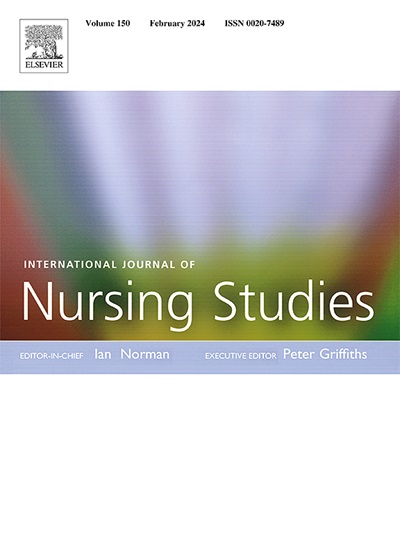影响急诊科患者疼痛管理的因素:一项混合方法的系统回顾
IF 7.1
1区 医学
Q1 NURSING
引用次数: 0
摘要
高达80%的急诊病例是由于疼痛引起的。尽管疼痛管理实践随着时间的推移有所改善,但在急诊科仍然存在疼痛管理不理想的情况。目的探讨影响因疼痛就诊于急诊科的成年患者疼痛管理结果的综合因素。采用乔安娜布里格斯研究所的聚合隔离集成方法,对混合方法进行了系统回顾。方法检索6个数据库,从成立到2024年10月检索相关研究,包括同行评议的英文初级研究。实证研究确定了影响疼痛管理结果的因素。数据库使用“医学主题标题”和“疼痛管理”和“差异”等关键词进行搜索。采用乔安娜布里格斯研究所的检查表对纳入研究的方法学质量进行了评估。数据通过荟萃分析和叙事描述进行综合,随后是定量和定性数据的收敛分离整合。症状管理理论指导了本综述的综合、解释和讨论。结果本综述纳入109项研究,107项定量研究和2项定性研究,报告了45个影响因素和25个结果测量指标,代表了症状管理理论的领域和维度。30篇论文纳入了最常见的因素(种族、年龄和性别)和结果测量(接受镇痛药物和阿片类药物)的荟萃分析。与非西班牙裔白人患者相比,非裔美国人较少接受镇痛药(OR 0.80, 95% CI 0.73-0.88, p < 0.001)和阿片类药物(OR 0.62, 95% CI 0.53-0.74, p < 0.001)。与非西班牙裔白人患者相比,西班牙裔患者接受阿片类药物的可能性也更低(OR 0.83, 95% CI 0.75-0.92, p = 0.04)。没有证据表明两性之间在接受镇痛药的可能性上有显著差异。与年轻患者相比,老年患者接受镇痛药和阿片类药物的可能性更小(OR 0.74, 95% CI 0.67-0.83, p < 0.001; OR 0.90, 95% CI 0.82-0.99, p = 0.03)。定性综合加强了定量结果,对精神和社会经济因素以及阿片类药物立法的作用提供了更深入的见解,这些因素影响了急诊科的患者体验。结论:这一混合方法的系统评价表明,由于与病情和严重程度无关的因素,几组患者仍然存在潜在的疼痛管理不足。报告因素和结果测量缺乏标准化,限制了我们能够充分识别这些关联及其对疼痛管理的影响的程度。未来的研究应纳入更多的定性设计、患者报告的结果以及标准化的数据测量和收集。系统评价注册IDPROSPERO - CRD 42024601076。本文章由计算机程序翻译,如有差异,请以英文原文为准。
Factors influencing pain management in patients presenting to the emergency department: A mixed-method systematic review
Background
Up to 80 % of all presentations to the emergency department are due to pain. Although pain management practices have improved over time, suboptimal pain management still occurs in the emergency department.
Objectives
To identify comprehensive factors influencing pain management outcomes among adult patients presenting to the emergency department with pain.
Design
A mixed-method systematic review was conducted following the Joanna Briggs Institute convergent segregated integration methodology.
Method
Six databases were searched from inception to October 2024 for relevant studies, including peer-reviewed primary studies in English. Empirical studies identifying factors influencing pain management outcomes were included. The databases were searched using Medical Subject Headings terms and keywords such as ‘pain management’ and ‘disparities.’ The included studies' methodological quality was assessed using Joanna Briggs Institute checklists. Data were synthesised through meta-analysis and narrative description, followed by the convergent segregated integration of quantitative and qualitative data. The Symptom Management Theory guided this review's synthesis, interpretation, and discussion.
Results
Included in this review were 109 studies, 107 quantitative and two qualitative, reporting on 45 contributing factors and 25 outcome measures representing the domains and dimensions of the Symptom Management Theory. Thirty papers were included in the meta-analysis for the most common factors (race, age, and sex) and outcome measures (receipt of analgesic medication and opioid medication). African Americans were less likely to receive analgesics (OR 0.80, 95 % CI 0.73–0.88, p < 0.001) and opioids (OR 0.62, 95 % CI 0.53–0.74, p < 0.001) compared to Non-Hispanic White patients. Hispanic patients were also less likely to receive opioids compared to Non-Hispanic White patients (OR 0.83, 95 % CI 0.75–0.92, p = 0.04). There was no evidence of a significant difference in the likelihood of receiving analgesics between the sexes. Older patients were less likely to receive analgesics and opioids compared to younger counterparts (OR 0.74, 95 % CI 0.67–0.83, p < 0.001; OR 0.90, 95 % CI 0.82–0.99, p = 0.03, respectively). The qualitative synthesis reinforced the quantitative findings, providing deeper insights into the role of spiritual and socioeconomic factors, as well as opioid legislation, which shaped patient experiences in the emergency department.
Conclusion
This mixed-method systematic review demonstrated that several groups of patients still experience potentially inadequate pain management due to factors unrelated to the presenting condition and severity. The lack of standardisation in reporting factors and outcome measures limited the extent to which we can fully identify these associations and their impact on pain management. Future research should incorporate more qualitative designs, patient-reported outcomes, and standardised data measurement and collection.
Systematic review registration ID
PROSPERO - CRD 42024601076.
求助全文
通过发布文献求助,成功后即可免费获取论文全文。
去求助
来源期刊
CiteScore
15.00
自引率
2.50%
发文量
181
审稿时长
21 days
期刊介绍:
The International Journal of Nursing Studies (IJNS) is a highly respected journal that has been publishing original peer-reviewed articles since 1963. It provides a forum for original research and scholarship about health care delivery, organisation, management, workforce, policy, and research methods relevant to nursing, midwifery, and other health related professions. The journal aims to support evidence informed policy and practice by publishing research, systematic and other scholarly reviews, critical discussion, and commentary of the highest standard. The IJNS is indexed in major databases including PubMed, Medline, Thomson Reuters - Science Citation Index, Scopus, Thomson Reuters - Social Science Citation Index, CINAHL, and the BNI (British Nursing Index).

 求助内容:
求助内容: 应助结果提醒方式:
应助结果提醒方式:


